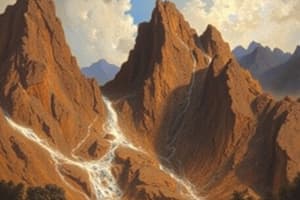Podcast
Questions and Answers
Which factor does NOT significantly contribute to making ore deposits economical?
Which factor does NOT significantly contribute to making ore deposits economical?
- The color of the surrounding rocks (correct)
- Proximity and ease of physical access
- The concentration processes involved
- Technological advancements in extraction
Which type of ore deposit is directly associated with black smokers?
Which type of ore deposit is directly associated with black smokers?
- Layered mafic intrusions
- Volcanogenic Massive Sulfide deposits (correct)
- Porphyry copper deposits
- Granitic pegmatites deposits
What geological setting is most commonly associated with the formation of porphyry copper deposits?
What geological setting is most commonly associated with the formation of porphyry copper deposits?
- Layered mafic intrusions
- Hydrothermal systems near magma chambers (correct)
- Impact structures
- Kimberlite pipes
In what type of rock are intrusion-related magmatic-hydrothermal deposits typically found?
In what type of rock are intrusion-related magmatic-hydrothermal deposits typically found?
What geological process primarily brings deeply rooted mineral deposits of igneous origin closer to the surface?
What geological process primarily brings deeply rooted mineral deposits of igneous origin closer to the surface?
Which geophysical method measures the change of rock density by looking at changes in gravity?
Which geophysical method measures the change of rock density by looking at changes in gravity?
What type of deposit are diamonds typically associated with?
What type of deposit are diamonds typically associated with?
What type of process concentrates heavy mineral resources in placer deposits?
What type of process concentrates heavy mineral resources in placer deposits?
Which geological feature is commonly associated with the Klondike Gold Rush?
Which geological feature is commonly associated with the Klondike Gold Rush?
In the context of ore deposits, what does 'origin' refer to?
In the context of ore deposits, what does 'origin' refer to?
Which of the following is a characteristic of lode deposits like the Coté Gold deposit?
Which of the following is a characteristic of lode deposits like the Coté Gold deposit?
What is the key process that makes nickel available in the Crawford Ni deposit?
What is the key process that makes nickel available in the Crawford Ni deposit?
What conditions lead to the desulfurization of existing sulfides during the formation of the Crawford Ni deposit?
What conditions lead to the desulfurization of existing sulfides during the formation of the Crawford Ni deposit?
Which of the following alteration minerals is a product of serpentinization?
Which of the following alteration minerals is a product of serpentinization?
What is the term for metal-bearing deposits where just a small amount of the element of interest is contained in the rock?
What is the term for metal-bearing deposits where just a small amount of the element of interest is contained in the rock?
What significant role have geophysical surveys played in the discovery of gold-rich areas, as exemplified by the Coté Gold deposit?
What significant role have geophysical surveys played in the discovery of gold-rich areas, as exemplified by the Coté Gold deposit?
How does the depth of a mine typically affect the mining costs?
How does the depth of a mine typically affect the mining costs?
Why are geological processes important in making resources economical?
Why are geological processes important in making resources economical?
What mining method is typically adapted for low concentrations of resources, such as nickel at Timmins?
What mining method is typically adapted for low concentrations of resources, such as nickel at Timmins?
What is the alteration product of olivine and orthopyroxene reacting with hot water?
What is the alteration product of olivine and orthopyroxene reacting with hot water?
Which of the following best describes a placer deposit?
Which of the following best describes a placer deposit?
What do seismic imaging and magnetotelluric methods help determine in mineral exploration?
What do seismic imaging and magnetotelluric methods help determine in mineral exploration?
Which mineral is known to be rich in fluid-soluble elements and originates from temporary serpentine reservoirs?
Which mineral is known to be rich in fluid-soluble elements and originates from temporary serpentine reservoirs?
What is the primary role of serpentinite dehydration in the formation of volcanic fronts?
What is the primary role of serpentinite dehydration in the formation of volcanic fronts?
Which conditions in the subduction zones favour the stability of serpentinites?
Which conditions in the subduction zones favour the stability of serpentinites?
Flashcards
Hydrothermal Deposits
Hydrothermal Deposits
Ore deposits formed through interaction with hot, aqueous fluids, often associated with igneous activity.
Layered Mafic Intrusions (LMIs)
Layered Mafic Intrusions (LMIs)
Ore deposits linked to layered mafic intrusions.
Impact Structures
Impact Structures
These structures, like Sudbury, can host ore deposits due to impact-related fracturing and alteration.
Granitic Pegmatites
Granitic Pegmatites
Signup and view all the flashcards
Kimberlites
Kimberlites
Signup and view all the flashcards
Carbonatites
Carbonatites
Signup and view all the flashcards
Porphyry Copper Deposits
Porphyry Copper Deposits
Signup and view all the flashcards
Volcanogenic Massive Sulfide Deposits
Volcanogenic Massive Sulfide Deposits
Signup and view all the flashcards
Intrusion-Related Deposits
Intrusion-Related Deposits
Signup and view all the flashcards
Porphyry Copper-Molybdenum-Gold Deposits
Porphyry Copper-Molybdenum-Gold Deposits
Signup and view all the flashcards
Seafloor Volcanism Deposits
Seafloor Volcanism Deposits
Signup and view all the flashcards
Volcanic Hosted (VMS)
Volcanic Hosted (VMS)
Signup and view all the flashcards
Origin of an Ore Deposit
Origin of an Ore Deposit
Signup and view all the flashcards
Occurrence of an Ore Deposit
Occurrence of an Ore Deposit
Signup and view all the flashcards
Placer Deposits
Placer Deposits
Signup and view all the flashcards
Gravity Imaging
Gravity Imaging
Signup and view all the flashcards
Seismic Imaging
Seismic Imaging
Signup and view all the flashcards
Magnetotelluric (MT) Imaging
Magnetotelluric (MT) Imaging
Signup and view all the flashcards
Low-Grade Deposits
Low-Grade Deposits
Signup and view all the flashcards
Lode Deposits
Lode Deposits
Signup and view all the flashcards
Coté Gold Deposit
Coté Gold Deposit
Signup and view all the flashcards
Serpentinization
Serpentinization
Signup and view all the flashcards
Desulfurization
Desulfurization
Signup and view all the flashcards
Accessibility
Accessibility
Signup and view all the flashcards
Concentration Processes
Concentration Processes
Signup and view all the flashcards
Study Notes
- Geology for Engineers - Winter 2025 - Day 6
- Ore deposits become economical based on factors like access, concentration processes, and technology.
Ore Deposits Linked to Igneous Rocks
- Some ore deposits are directly linked to igneous rocks, suggesting a genetic association between magmatic processes and ore formation.
- Hydrothermal deposits systems are developed around magma chambers, often in silicic volcanic terranes.
- Layered Mafic Intrusions (LMIs) can host significant ore deposits due to the separation and concentration of elements during magmatic crystallization.
- Impact structures, such as the Sudbury impact, can create unique geological environments conducive to ore formation.
- Granitic pegmatites are known for rare element mineralization due to extreme fractionation of magma during their formation.
- Kimberlites are the primary source of diamonds, transported from the mantle to the Earth's surface through volcanic pipes.
- Carbonatites, rare igneous rocks, can be enriched in rare earth elements and other valuable minerals.
- Porphyry copper deposits are large-scale deposits associated with intrusive igneous rocks and hydrothermal activity.
- Volcanogenic Massive Sulfide (VMS) deposits are linked to seafloor volcanism and the activity of black smokers, which precipitate sulfide minerals.
Magmatic-Hydrothermal Deposits
- These deposits are associated with both magmatic and hydrothermal processes
- Intrusion-related deposits are associated with felsic, plutonic rocks.
- Porphyry copper-molybdenum-gold (Cu-Mo-Au) deposits can form in these intrusion-related settings.
- Seafloor volcanism (mafic, volcanic) can lead to the formation of Volcanic Hosted (VMS) deposits containing copper, lead, zinc, gold, and silver.
- Hot springs can deposit gold and silver.
- Epithermal deposits contain gold and silver.
- Mesothermal veins contain gold and silver.
Mineral Deposit Accessibility
- Mineral deposits of igneous origin are typically rooted deeply but are brought closer to the surface through weathering and erosion.
- The ease of discovering concentrated resources renders them as economical reserves, such as metal-bearing VMS, diamonds, and gold.
Seeing Deep into the Earth
- Gravity imaging measures changes in rock density by looking at variations in gravity.
- Seismic imaging provides a way to see deep into the Earth.
- Magnetotelluric imaging is a geophysical method used to image the Earth's subsurface.
- 3D imaging overlays geophysical methods in the Rouyn-Noranda transect.
Origin versus Occurrence
- The origin of an ore deposit relates to the primary geologic environment of formation, such as diamonds forming at 250 km depth in the mantle.
- The occurrence of an ore deposit relates to where the mineral is found today, such as diamonds found in kimberlite pipes after transportation to the surface.
Placer Deposits
- Placer deposits form due to varying flow speeds in a river channel.
- The water separates minerals by specific gravity, concentrating heavier minerals in slower-moving sections.
- Winnowing concentrates heavy minerals such as galena, native gold, and diamonds.
- Examples of placer deposits: Klondike Gold Rush, Witwatersrand South Africa
Coté Gold, Gogama, ON
- Coté Gold is a low-grade bulk-tonnage Archean deposit (lode Au deposit) with minute amounts of gold contained in the rock.
- It includes porphyry Cu-Au, syenite-associated disseminated gold, and reduced Au-Bi-Te-W intrusion-related deposits.
- Detailed mapping, sampling, and geophysical surveys have revealed hydrothermal alteration, targeting gold-rich areas.
- The Harquail School of Earth Sciences played an instrumental role in its discovery in 2010.
Serpentine Alteration
- Mantle peridotites overlying subduction planes are continuously hydrated during slab dehydration, becoming enriched in specific elements.
- Serpentinites are transported downward and break down at ~100 km depth, releasing H₂O.
- Ultramafic minerals (olivine and orthopyroxene) are unstable under low-pressure and temperature conditions.
- As a result, magnesium (Mg), iron (Fe), and trace amounts of Ni are detached from silicate minerals.
- The resulting products are serpentine, iron oxides, and Ni minerals.
- Olivine and orthopyroxene react with hot water to liberate cations (Fe2+, Mg2+, Ni2+).
Low-Grade Ni Deposit
- Lode deposits are metal-bearing deposits containing minute amounts of the element of interest, often due to lack of concentrating processes.
- The Crawford Deposit has at least 5 times lower concentrations of Ni compared to Sudbury deposits (>2 wt% Ni).
- Serpentine type is added due to hydrothermal alteration of ultramafic rocks, resulting in a few secondary minerals dominated by serpentine.
- The hydration of Ni-bearing olivine paired with desulfurization results in remobilization of nickel.
- Silicate nickel trapped inside olivine is concentrated in secondary sulfides and alloys.
- The ore would be mined in an open-pit concept by bulk tonnage
Day 6 Summary
- It is crucial to focus on near-surface ore deposits.
- Geological processes concentrate resources, making them economical.
- Finding deposits requires knowing rock types, associations, age, and structures.
- Low concentrations of resources can be economical with adapted mining methods (open pits).
- Geophysical methods (gravity, seismic, magnetotelluric) are invaluable for understanding mineral resource extent.
Studying That Suits You
Use AI to generate personalized quizzes and flashcards to suit your learning preferences.



